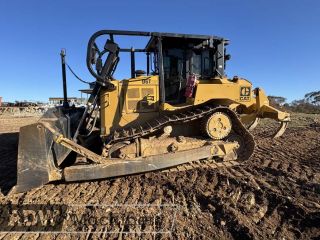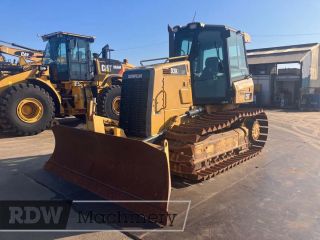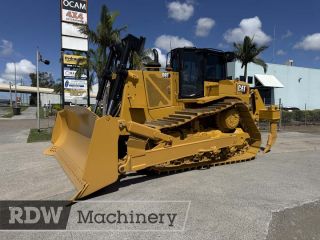Dozers
Bulldozers
Known especially for their exceptional pushing ability (like a bull), Bulldozers (or dozers for short) are tracked machines fitted with a front blade for pushing large quantities of earth, and also typically feature a rear fitted ripper to loosen densely compacted materials. Because most dozers are continuously tracked, they are sometimes also referred to as crawler tractors. Dozers are used in many applications from mining and quarries, to construction, agriculture, forestry and even military. The tracks give the machines excellent ground holding capability and traction through challenging terrain, whereby bulldozers are the preferred machine to push large quantities of soil, sand, rubble, rocks, and other earth, or to rip up hard ground or tree stumps.
In Australia, the market leader is Caterpillar followed by Komatsu, with other brands such as Liebherr, Case and Dressta also present.
What do the various sizes mean?
There is no standard for determining machine size classes, however most manufacturers models have larger numbers on larger machines. Whilst model capacities have changed over the years (for instance an old D11 is similar to a current D9/D10), model comparisons between brands use a rule of thumb based on engine horse power output and/or operating weight. As Caterpillar are currently removing the suffices from their model nomenclature, the below approximate chart is indicative only, hence please discuss your requirements with our sales team.
Dozer Model Chart
Approximate size comparison chart between Caterpillar and Komatsu bulldozer models
The largest dozer ever built was an Italian Acco dozer in 1986, weighing 183 tonnes. It was based around Caterpillar componentry and used twin 675HP Cat engines. The blade was 7m wide and 2.7 meters tall, whilst the ripper was 3m tall. However, due to various circumstances, production never got under way. The bragging rights for the largest Dozer in production is currently held by Komatsu with the D475-8 (1040HP and 112 tonne) ahead of Caterpillars’ D11 (850HP and 104 tonne). Komatsu also produced a larger D575, but with less than a dozen built it was taken out of production.
Blade Selection
The heavy metal blade on the front of the dozer comes in three common varieties:
- A straight blade (“S Blade”) is a short blade with no lateral curve and no side wings and is generally designed for fine grading.
- A universal blade (“U Blade) is tall and very curved with large side wings to carry more material.
- An “S-U blade” (semi U) combination is shorter than a U blade and has less curvature and smaller side wings, making it more suitable for pushing piles of large rocks at for instance quarries.
Most blades have removable edges and end bits. These work as wear parts (ground engaging tools or GET) and are designed to prolong the life of the blade. Most dozers are fitted with lift and tilt cylinders to allow optimum control of the blade angle to maximise fill rates and pushing forces whilst moving.
Track selection
Whilst there are some wheeled bull dozers, most have metal tracks fitted. There is conjecture about the benefits of high track machines (where the tracks run in a triangle configuration) compared to a low track design (where the tracks run parallel to each other). Both types have link assemblies fitted with track plates (also known as grouser plates). The tracks primary purpose is to give maximum traction (pushing/pulling force), however in some cases fitting wider tracks can help distribute the dozers weight to decrease ground pressure, which is helpful to reduce sinking in sandy or muddy ground. Extra wide tracks are known as low ground pressure (or LGP) tracks and have the traditional “bar” configuration on the track plate. There are also swamp tracks available, which apart from being wide have a chevron or diamond shape instead of the bar design. Caterpillar also offers a patented “SystemOne” track option on some models, which has some features such as a rotating bushing design (to eliminate bushing turns) and more guiding for the track, but locks the owner into replacement parts from only one source.
Ripper selection
Rippers are long claw like devices fitted to a draw bar at the back of the dozer and are used to break up hard ground to make it able to be handled by the dozer or other types of earthmoving machinery. Rippers come in two main forms:
Single Shank Rippers have one large ripper and is used for heavy ripping.
Multi Shank Rippers have two or more smaller shanks to give a larger (but shallower) rip area in each pass.
Shanks usually have replaceable ripper boots (or tips).
What to look for when buying a Bulldozer
Because dozers are usually moving and constantly under load, ensuring that the machine has been well looked after and is in good condition is probably more important with a dozer than any other type of earthmoving machine. Buy your machine from a reputable dealer like RDW Machinery, and make sure you pay attention to these key areas:
Undercarriage is the most costly wear area of the machine, so check the wear levels. Whilst top and bottom rollers can be replaced individually, it is usually recommended to change full undercarriage together as they wear in with each other. One of the key decision criteria is to ensure that the dozer has the correct configuration for your job (standard, heavy duty or extreme service (ES), or swamp tracks).
Check component condition, including any available service history. Some larger dozers can run for close to 100,000 hours, but that obviously requires a good service history and components to be rebuilt generally before failure. Check oil samples (SOS results), and inspect engines, transmissions and final drives especially.
Other considerations include making sure that the specification matches your expected usage (correct blade type and ripper assembly, fitted with required accessories such as e-stops, fire suppression systems etc as required).
Bull dozers generally require a high capital investment, and whilst they generally have reasonably high charge out rates, the ownership costs can be high too. The main costs are depreciation and cost of capital, repairs, and variable running costs (fuel and operator). Whilst it can be tempting to buy something cheap, the best way to reduce the total cost of ownership is to buy a good used machine from a trusted seller.
The ready availability of new replacement and aftermarket parts for Caterpillar machines generally means that the operating costs can be kept down, however Komatsu machines have a good reputation for reliability and after market parts are becoming more available. As dozers are a significant investment, having high up time is essential, so our recommendation is for buyers to buy a machine that is unlikely to have unexpected down time due to break down or having to wait for parts to get it back into operation. Whilst there are other brands making inroads into the dozer market, we feel that the best value and supported (for parts) bulldozer is still Caterpillar followed by Komatsu.
Still need help?
Choosing the right machine for your job is very important and can be confusing. The above covers some of the application and design considerations. To ensure you get the right machine to meet your requirements, call RDW Machinery on 07-3875 1358 to discuss.




